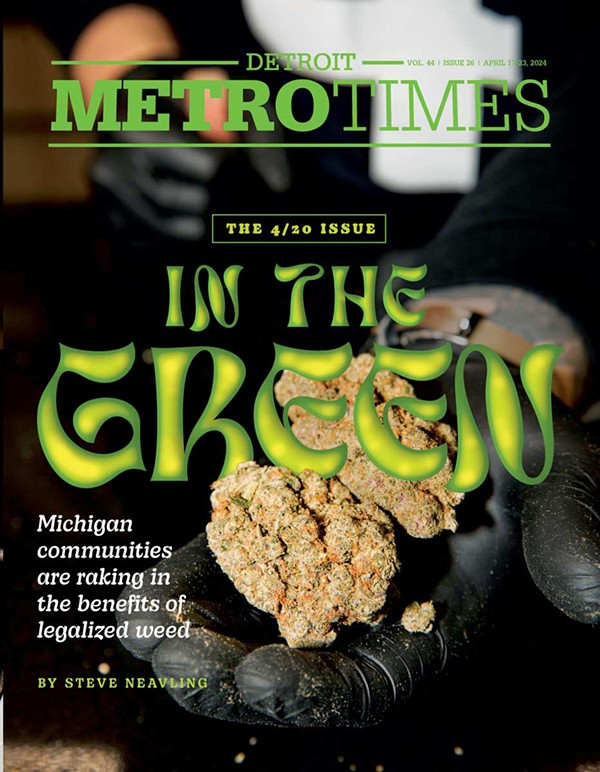Punk rock is a loaded term these days. It's evolved (and devolved) and changed meaning enough times over the years to render it virtually meaningless in 2009. The story goes — and it's mentioned in this book — that Detroit rock critic Dave Marsh first used the term in 1971 to describe fellow Michiganders Question Mark & the Mysterians. But there was a period, pre-CBGB and Johnny Rotten, when the term "street punk" wasn't just applied to the garage rock Nuggets "punk" bands of the '60s but also to musical artists as diverse as Lou Reed, Bruce Springsteen and Phil Lynott. Over time, however, it became little more than a young person's fashion statement, and when one considered that Sha Na Na came only a decade after the era it was lampooning, the idea of rich suburban kids in purple Mohawks and safety pins became all that more absurd.
One of the problems of exploring the classic mid-to-late '70s heyday of punk — as Nicholas Rombes, an English professor at the University of Detroit Mercy, attempts to do in this very entertaining book — is that there were conflicting attitudes between the respective scenes in America and England. Particularly in New York, American punk was an intellectual, more cerebral movement or revolution; one needs look no further than Patti Smith or Television for proof (even the Ramones and Dead Boys were too brilliantly stoopid to actually be dumb). In Britain, however, it was a more political and social revolution, born out of a collapsed economy and a bunch of working-class kids staring into a void that Johnny Rotten labeled "No future." Rombes' book tries to bridge those two attitudes (along with trips to L.A., Cleveland and a few other locales) via his unorthodox "dictionary," which he describes as a series of investigations into the "raw materials of punk."
You've surely got to respect any punk scholar whose "raw materials" include such brilliant (and occasionally outlandish) touchstones as Truffaut's The 400 Blows, Philip Glass, Marlon Brando, Spiro Agnew, John Fante's Ask the Dust, the Captain and Tennille, Alice Cooper, William Gibson, Lester Bangs (lots of Lester Bangs) and Herman's Hermits. There are three separate listings for the word "Blank" before the reader even gets to a listing for Richard Hell's "Blank Generation." Elsewhere, there's even an entry for "Down-and-out During the Punk Era, the fun of being."
Often, an entry will be for an album or song title rather than for the band or artist that recorded them, using the work of art as a jumping-off point for thoughts on Gang of Four, the Jam and others. Some entries take the form of short stories; there's one based around Suicide's "Frankie Teardrop." Joey Ramone gets a 10-page treatment, before several more Ramones items (including an entry for "the first line from each song on the first three Ramones albums"). And Patti Smith gets an eight-page story, simply titled "Patti" ("She called herself Patti Smith but who could know for sure?" it begins) — this in addition to a separate entry for Horses (Rombes obviously digs Patti) — although it's left to the reader to determine if it's fantasy or fact (especially since, elsewhere, he uses the literary device of transforming himself into a character he calls Ephram B. Noble, who appears at various points in the book).
There will be quibbles. Rombes appears to be trying to never state the obvious — no mention that Johnny Rotten sang an Alice Cooper song to audition for the Sex Pistols in the Cooper entry; no mention that the Pistols' last performance was at a Bill Graham venue, during which Graham was horrified, in the Graham entry; no mention that Elvis Costello covered the Damned's "Neat, Neat, Neat" (perhaps in punk solidarity) in the entry for that song. Some readers may question whether the Germs were really ever that good. And some aficionados may question what happened to the listings for, say, William Burroughs or James Dean or Elvis Presley in a book with such intellectual leanings and historical detail. But then, the purpose of most such books is also to instigate debate, and much like Michael Gray's Bob Dylan Encyclopedia a few years ago, it will certainly do that.
But it should also be great fun for fans of things like Punk and CREEM magazine, as well as the music, attitude and thought of that fantastic era. Rombes only includes one post-1982 landmark in his book — not the Replacements, not California hardcore, not Green Day, but an entry for "Nirvana (1986-'94)," which begins by asking if Cobain and crew "were so good, why did they become so popular?" That's the kind of food for thought the book delivers throughout many of its 320 pages.
Bill Holdship is the music editor of Metro Times Send comments to [email protected].

